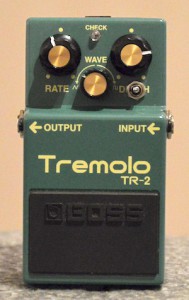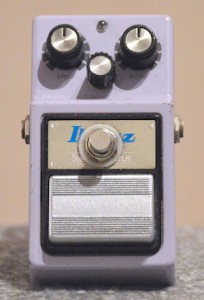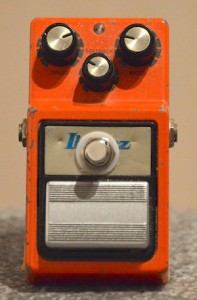Voodoo Lab Tremolo
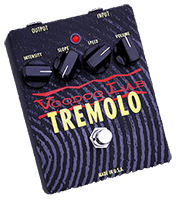
I got this one when I was using a Boogie Blue Angel combo and needed a tremolo for one song. Actually, I didn’t get this pedal – I bought the Boss TR-2, used it on the gig, then took it back the next day and got this instead. The Boss was not a bad tremolo (I later bought one of those too), but it had a really annoying volume drop when active. For sure, this is a feature on amp tremolos also (and it’s not really a factual loss of gain, it’s a perceived loss of gain as a tremolo works by intermittently dropping the volume. In the peaks the gain may be at 100%, but as it is lower in the valleys, we perceive that as an overall gain loss.) But – it feels different when the loss is on the preamp side, rather than in the power amp as with an amp tremolo. You lose punch and definition – not good. The Voodoo Lab has a volume knob to combat this, plus true bypass and great sound. It also has an ace up its sleeve – if you set the intensity to zero, you can use it as a clean boost. The sound gets fatter and louder – perfect for solos! I hear reports of switches acting funny and breaking – but I’ve never had so much as a hint of a problem with this one, so I can’t really comment on that. I guess I don’t stomp too hard, then…
Boss TR-2 Tremolo
As mentioned above, I originally passed on the TR-2 because it had a perceived volume drop when engaged. I later bought one anyway, to use on my small rehearsal/to-go pedalboard, and modified it to have a better output level match. The pedal has a three-way switch which selects (you guessed it!) three different output level settings. The pedal now goes from ”slightly above unity gain” to ”quite a bit more” in three simple steps 🙂 It should be mentioned that TR-2’s made after mid-2006 (marked with RoHS stickers) have a higher output level from stock, so the volume drop issue is not as big a problem with those.
I also briefly owned a Boss PN-2 Tremolo/Pan, and while the panning effect was really cool, I found the tremolo to be too choppy for me – I prefer the Fender amp tremolo sound, which the TR-2 does very well.
Mooer Trelicopter

Yes, another cheapo Chinese knock-off 🙂 As mentioned in the distortion section, I got to try out a bunch of the Mooer pedals, and found them to be quite uneven. Some were awful, others just fine while a few were spectacular. This was one of the latter group, so it stayed. The Trelicopter is often referenced as a copy of the Demeter Tremulator, and it sure sounds like it. It has that syrupy, swampy ”vintage amp tremolo” feel to it, that few pedals can replicate. The ”bias” control (internal trimpot on the Demeter pedal) is subtle, and the pedal never strays from its basic sound. So if you’re looking for modern square-wave tremolo effects, this one might not be for you. But if you’re into Ry Cooder and that type of tremolo, it’s just right. The only thing that would beat it would be a Demeter Tremulator…
The Trelicopter comes with a bunch of different opinions with regards to its output level – some say it has a definite volume drop when engaged, while others claim it has a quite large volume boost. I found it to be just about perfect with the tremolo set to ”normal” settings (not too fast, not too deep). Of course, since tremolo in itself is an effect that spends part of the time lowering the volume, you have to compensate for that somehow. I would have preferred if the pedal had a volume control, but they instead opted for trying to find a fixed balance. This means you’ll get a volume boost when the intensity is set low, and a volume drop with it set really high (especially if the speed is also turned up). At the settings I ended up with, the level was just a tad too high, so I went back to the Voodoo Lab Tremolo. When/if I get the time, I might look into making the output level adjustable on this one, although even fitting a trimpot – let alone a real pot – will be a challenge!
I did one small mod to it (if you can call it that) – I added a tiny drop of white-out in the little pointer slot on the two tiny knobs, which made it much easier to see where they’re set.
Mooer Ensemble King

Impressed as I was with the Trelicopter, I decided to order in a couple more Mooers that my local store didn’t have. One of them was the Ensemble King chorus. Now, there’s tons of discussion forum threads about which classic circuits Mooer copied for their Micro Pedals line, and while some of the info seems right (the Trelicopter does sound like a Tremulator, and the Black Secret is most definitely a RAT), this one is a little harder to pin down. ”Ensemble” seems to hint at the venerable Boss CE-1 Chorus Ensemble, but that one only had a single ”intensity” control for the chorus. Others point towards the CE-2 (since it has both speed and depth controls), but it didn’t have a level/mix control. Set that knob to max, though, and you can absolutely hear a resemblance to both of them. But it doesn’t really matter – this one is seriously good on its own! The level control allows you to mix in just the right amount of chorus with the dry signal, keeping it just on the right side of ”too much” (which I sometimes feel both the CE-1 and CE-2 can be).
Again, I used the white-out trick to give the small knobs a white pointer line. Just dab it in (don’t worry about spilling over on the top, but try to keep overflow away from the grooves in the sidewalls) and when it’s dried, scrape any excess off with a sharp knife.
TC Electronic SCF
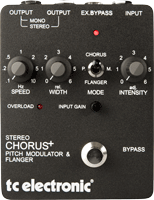
A true classic – the SCF has been around for ages, and in some respects it is still unbeaten. They used to market it as being studio-quality effects in a pedal, and I think it is still true. The chorus is lush, without being overpowering. And as you can set the amount of chorus relative to the dry signal, you can get as 80’s (or not) you like. I got this on eBay UK (as it is mains-powered, buying one from the US wasn’t an option), with a UK mains plug. I ended up replacing the mains cable completely, to get a slim molded euro 2-prong plug on there.
It did come with a problem, though – it made every pedal after it pop loudly when turned on/off… I measured for DC leakage on the output of the SCF, and to my amazement found close to 6 volts! I replaced all DC blocking capacitors, but that didn’t help. In the end, I was able to get it under control using pull-down resistors on the output jacks… I did contact TC support about it, just asking if it was something they’d come across before. After all, the SCF is still in production, so they might know a thing or two about it. Well, I got a reply basically saying two things:
We don’t provide DIY support.
We don’t have any techs around who know these old pedals.
Well, in their FAQ section, they do mention adding 1M resistors to the output jacks to stop it popping when using an external true bypass loop box, so someone obviously knows something… But in my case, as the voltage leak was so large, 1M resistors didn’t do much. I believe I eventually had to go down to around 300K or so for each jack, to handle the leak and stop the pops.
Eventually, I got it working without issues, and it is the best chorus pedal I have ever owned… with the ”intensity” (mix) knob set around 2, I get just the right amount of chorus for clean playing, without it being overbearing if I happen to step on the pedal during a solo. It is an awesome chorus, simply put.
Ibanez CS-9 Stereo Chorus
Bought cheap from Estrad (later 4sound Stockholm, even later defunct) – I came into the store one day, saw it in the used fx bin and said “I’ll take it”. 400 SEK later I walked home with a great chorus with a bonus – it boosts your signal. Apparently Ibanez didn’t compensate for the fact that it adds a detuned, wobbly signal on top of the original one – making the sum louder. A cool, but quite bright and not very discrete chorus. The pedal is a silver label, made in Japan with serial # 290719 – whatever that means… Oh, and I’ve ruined any vintage value it had by modifying it to true bypass… 🙂 Since I knew I wouldn’t be using it that much, I wanted to be able to have it sitting on my board without adding anything to the signal. I’ve defaced it even further since, by adding a chorus level knob to set the wet-to-dry ratio. Now the pedal works much better, without scaring people… I have since traded it for a Boss CE-3, since I wasn’t using it and wanted to try another chorus flavour.
Boss CE-3 (coming)
I traded my Ibanez CS-9 for this one. I will write some more about it, eventually 🙂
Behringer UV300 Ultra Vibrato
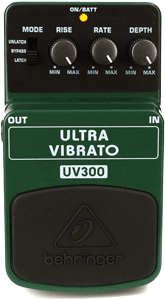
Yup, a cheap plastic Behringer made its way into my hands… Well, ok, I knowingly placed an order for it 😉 No fancy story here – I heard some talk about the UV300 on the Swedish ”Ultimate Guitar Gear” podcast, threw it in with a larger order of stuff, and it arrived a couple of days later.
These pedals are a little hit and miss – some of them are almost 1:1 circuit copies of other (more expensive) pedals, while some try their best but fail spectacularly (I once tried the US600 Ultra Shifter, and that one definitely was in the latter camp). The UV300 is reported to be one of the good ones, so not having the money to buy a real Boss VB-2 I decided to check it out. I haven’t gotten around to it yet, but it’s here, at least.
MXR M101 Phase 90
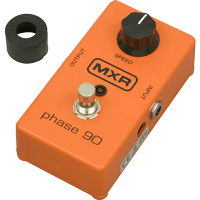
This is a recent Dunlop reissue model that I bought through eBay – no special story there. Ok, I’ve modified it for true bypass, which isn’t that easy to do (more on that later). I’ve also made the phasing a bit smoother (via the age-old ”script” or ”R28” mod), as well as deeper and more like a Uni-Vibe. It’s not a proper ’vibe, but it’s somewhere in that region. It works really well in front of my overdrive pedals, for those Hendrix-y moments…
Removing the feedback resistor (labeled R28 in the modern reissue pedals) brings the circuit closer to the original MXR script logo pedals’ sound. But not all the way – the script logo pedals had a different circuit altogether. But it’s as close as you will come, without buying the MXR 1974 Vintage Phase 90. The Custom Shop Script (CSP101SL) version is good, but in no way ”vintage” – it is simply an EVH phaser in a vintage-looking box. For my money, if I can’t have a vintage one, or the 1974 Handwired model, I’d just as well have a regular M101 with a simple mod.
Anyway, modifying the modern Dunlop/MXR reissue pedals for true bypass isn’t as easy as it seems – the existing switch is soldered directly to the circuit board. In order to fit the new 3PDT (triple pole, double throw) switch needed for true bypass and LED control, I had to make a cutout in the circuit board and fly wires to/from the proper positions on the pcb. Not really a beginner’s job, I admit – there are circuit traces on both sides of the circuit board, and you can’t cut all of them off. But it was fun to break out the Dremel and cutting discs…
Roland Jet Phaser AP-7
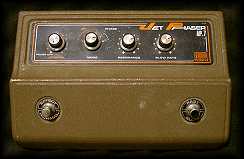
This pedal was given to me, together with an old DOD 270 A/B box, by a close friend who stopped using it when it broke down somewhere in the ’80s. It was a bit beat up and rusted, but after afternoon of tinkering it was up and running. The Jet modes still don’t work properly – I think the “jet level” pot is busted – but the regular phase modes are dreamy. To my amazement it had a factory installed DPDT switch, and was wired for true bypass! Plus it has a fast/slow stomp switch, and when you change speeds, it ramps up/down like a leslie… It stole a bit of gain when kicked in, though, so I set about raising the output gain. I did, and in the process the whole effect became much more vibrant and defined. The gain went up just a tad too much, though, so I’ll eventually have to put it back on the workbench to tame it just a bit. I don’t use this pedal live anymore, but it will sometimes make an appearance in recording sessions.
Ibanez PT-9 Phaser
I got this from a guy in California, from who I was originally only going to buy a used Boss Blues Driver. I noticed that he also were selling this ’80s phaser pedal, and the ”what-the-hell” reflex kicked in. So I simply said ”what the hell”, and had him send me this one as well. It’s a little scuffy, and the switch was quite hit-and miss. But it sounds nice – more shimmery and hi-fi/post processing-sounding than a Phase 90. It’s a nice smooth phaser, basically.
I ended up stealing its bottom plate to fit to the TS-9, so when I decided to use this one on the board, I had to fabricate a bottom plate for it. I also modified it to true bypass, since I knew it would spend most of its time sitting bypassed on the board (I tend to use phaser as a ”once or twice per gig” effect).
Korg G4 Leslie simulator
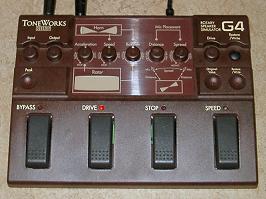
I have a real leslie cab (Fender Vibratone), but felt there would always be moments where I wanted the sound but couldn’t find room on stage for the real thing. Dave Fox of Foxrox Electronics kept raving about the Korg G4 – an older leslie simulator – so eventually I caved, and located one via eBay Germany. It cost me 120 € + shipping, but that’s ok – these puppies go for way more than that these days… It’s not a permanent fixture on the pedalboard, partly due to its size and partly because I sometimes actually bring the real deal to gigs. Instead, I keep it on a separate pedalboard together with a true bypass loop box, and simply patch it in between the main board and amp.
Anyway, the G4 was introduced in 1994 as part of the ToneWorks line, and does a great impression of a Leslie 122/147, complete with the frequency hole between the horn and woofer – a feature of the original that is often overlooked. I won’t go into too much detail here, but the crossover network in a Leslie cabinet splits the signal to the horn and woofer at 800Hz, while the horns’ frequency range starts at 1000Hz… This mismatch is a vital part of the leslie sound – it’s what causes the horn to growl so nicely (due to it being asked to reproduce frequencies it can’t handle), and it also leaves a ”hole” in the frequency response around 800Hz. The G4 mimics this perfectly, plus it has a ”Drive” section to capture the fat, growling sound of a tube power amp being asked to do more than it’s capable of. Not bad at all.
Danelectro Rocky Road
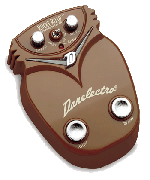
This one is quite an oddball… What ever possessed Danelectro to include a leslie/rotating speaker simulator in their line of mini pedals is a mystery – considering how small that market must be – but there it is. I had been wanting to try it ever since I first heard about its existence, but wasn’t able to locate one here in Sweden. I finally got my grubby hands on one, when a friend went to the US on holiday and was kind enough to bring one home for me. Musician’s Friend had them on sale, so it ended up costing a mere $20… Now, that’s a bargain, if I ever saw one! So what’s it like? Well, I’m utterly amazed at how well this little thing does the single-rotor Leslie 16 / Fender Vibratone sound. As opposed to other – more expensive – simulators, this one doesn’t allow for the ”horn” and ”woofer” to spin at different speeds. Instead, when the Rocky Road spins up to speed, the whole frequency range accelerates uniformly – just like a Vibratone does. This is probably more due to design limitations than any specific goal set by the design team, but it still places the Rocky Road in a class of its own. The other simulators I’ve tried – H&K Rotosphere, Korg G4, Voce Spin etc – are all very good at sounding like a woofer/horn type leslie (122/147), but this is the only one that even gets close to sounding like a Leslie 16 / Fender Vibratone.
Now, to the bad points. First off, the pedal has a nasty volume boost, even with the ”drive” knob at zero. Including a small amount of overdrive can help you get closer to the real sound, but this is way too much. Especially since there’s no provision for setting the output volume compared to the bypass level. Unless you plan on keeping the pedal active at all times, the pedal needs to be modified. Luckily, there is a relatively easy mod here, which you can do yourself if you feel confident enough. If not, you can take it to someone to have it done – it shouldn’t be too expensive. It is definitely worth it – after the modification, the output level is at unity gain when the ”drive” knob is at zero. If you need a little more push to your leslie, just give it a little drive. Why Danelectro chose to ship the pedals the way they are – and continue to ship them this way – is beyond me.
Another drawback is the miniature plastic casing – it is so small, that hitting the switches with any sort of accuracy requires one to take off their shoes, using the big toe to prod the switch. I’m not joking – that’s the only way I’ve been able to work it… And even with the shoes off, the switches need a good prodding to actuate, which means that you can’t be 100% sure the thing is actually going to change speed (since there’s no LED to indicate speed status). On my (ever-growing) to-do-list, there’s now an entry about rehousing the circuit into a bigger, sturdier box.
But all in all – if you are looking for a decent single-rotor leslie sim, it does a fine job indeed. Thumbs up for Danelectro! Now, can we have it in a bigger box, please?
